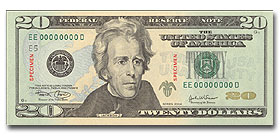NEW YORK (CNN/Money) - Less than a month after the release of new $20 bills with features designed to deter forgeries, counterfeiters are already at work.
Last week, people in and around Brockton, Mass., tried to pass fake notes at a convenience store, a restaurant, and a Radio Shack, according to the Brockton police department.
 |
|
| Old Hickory's new look. |
In an unrelated incident on Tuesday, phony bills showed up at a convenience store in Quincy, Mass., according to Steve Ricciardi, Special Agent in charge of the Secret Service's Boston office. An arrest was made in Quincy, he noted, but there have been neither arrests nor suspects in the Brockton case.
The Massachusetts scams were not the only recently reported forgeries. In Indiana, at least five fake notes have been passed.
A restaurant in Elkhart, Ind., found two of them. A teen-aged girl had been the one to spend the bills, police said, though they have not since located her for questioning.
Three other counterfeit bills have also turned up in the area in recent days, according to Tom Cutler, a lieutenant and spokesman for the Elkhart police. "All of them have been what I'd call 'sophisticated copies,' not ultra high-tech notes," he said.
| Related Stories
|

|
|
|
|
Federal officials said they expected to see counterfeiters try to take advantage of the release of the new bills, and are prepared for it.
"We see this every time there's a new note put into circulation -- people try to challenge the system," said Jeannie Mitchell, a Washington-based spokeswoman for the Secret Service. "In 1996, we saw the same sort of thing happen early on, before levelling off."
Discoveries are good
When the government announced last spring that the $20 note would be redesigned, officials stressed that the move was driven by a desire to stem counterfeiting.
News that fake bills are already being detected, therefore, may be evidence that the plan is working. (By definition, the discovery of a counterfeit note means an attempt at fraud has been thwarted.)
Among the new $20's security features are a watermark image engrained into the paper; an embedded vertical plastic strip; and color-shifting ink, whose appearance changes in hue from copper to green as the bill is tilted against light.
The most obvious change is that the greenback is no longer just green and black. The new $20 contains pastel background colors of pinkish-orange and powder blue, in addition to different shades of green.
In the case of the Elkhart forgeries, Cutler said that the color-shifting ink was obviously not present. "If you gave them a good glance, you could see they were different," he said. "Part of the problem is that not enough people have seen the new ones yet, so they don't know what to look for."
In Massachusetts, too, the false notes lacked enhanced features. "There was no security strip, no red-and-blue fibers in the paper, and the watermark was missing," said Ricciardi.
As the Secret Service's Mitchell noted, the government's outreach campaign is explicitly designed to help people identify an authentic bill. "It's usually pretty easy to tell when a note is a fake," she said. "It's very rare that they're so well done that you can't tell the difference."
Only 1 bill in 10,000 is illegitimate, according to the Secret Service, but widespread access to digital printing technology has made counterfeiting easier in recent years.
The U.S. government seized about $130 million in (unused) counterfeit notes last year, according to the Secret Service. Almost $44 million more was retrieved from circulation. Nearly 5,000 people involved were arrested.
The multicolored new bills represent "an opportunity to be proactive," according to Steven Carey, who runs the Secret Service's New York operations. "We're using new technologies to stay one step ahead of the counterfeiters."

|

